| Author |
Message |
Blaz Berlec

|
 Posted: Mon 04 Oct, 2010 12:57 pm Post subject: Evidence of mirror polished armour Posted: Mon 04 Oct, 2010 12:57 pm Post subject: Evidence of mirror polished armour |
 |
|
I assume you have all seen this description of armour finish in Gerry Embleton's 'Medieval Military Costume Recreated in Colour Photographs':
| Quote: | | "Armour was valuable, and its appearance a matter of prestige; there are many references to its being cleaned - with pumice and olive oil - and polished to a glorious shine. The author has twice been privileged to see the original surface of plate armour, in tiny sections hidden under other parts and so protected for centuries from the ferocious cleaning which has altered the surface of nearly all museum armours; it was exactly like an immensely hard modern steel mirror..." |
Gerry Embleton, 'Medieval Military Costume Recreated in Colour Photographs'
One of those armours with original surface was discovered in Madonna della Grazie church in Mantua, Italy, where it has been used on a funerary figure, covered in plaster and paint.
I have seen in various topics on forums debates about the commonality of "mirror finish", and I have seen several depictions of such finish in contemporary art. I have found several I haven't seen mentioned before, and some were mentioned in a more closed forum, so I decided I'll share them here as well.
My intention is not to somehow prove that mirror polished armour is the only correct finish. But I think the abundance of evidence in artwork shows that it was an available finish, and not only for the high end princely suits of armour.
Thumbnails, click for full sized image:

1435 Knights of Christ, Ghent altarpiece by Jan van Eyck

1435 Heilspiegel Alterpiece by Konrad Witz

1470 Hans Memling - Last Judgement - landscape reflecting in gilded breastplate
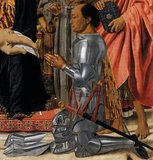
1472 Montefeltro Altarpiece by Piero della Francesca - helmet is highly polished while armour has almost satin finish

1475 Federico da Montefeltro by Justus of Ghent

1498 Judgement of Cambyses by Gerard David

1498 Judgement of Cambyses by Gerard David - detail

1499 Pietro Peruginno - Polyptych of Certosa di Pavia

1503 Albrecht Dürer - Side, Front, and Back View of a Helmet - it's not very obvious, but if you look closely points are reflected on the surface

1510 Vittore Carpaccio - Portrait of a Knight - blackened armour, but it still looks polished to high piano gloss!
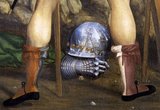
1510 Il Sodoma - Deposition from the Cross detail - this reflection doesn't really follow the curvature of the helmet too well

1548 Tintoretto - The Miracle of St Mark Freeing the Slave - it's a bit dark, but armour really looks polished

1613 A Commander Being Armed for Battle by Peter Paul Rubens
Extant 15th Century German Gothic Armour
Extant 15th century Milanese armour
Arming doublet of the 15th century
Last edited by Blaz Berlec on Mon 04 Oct, 2010 1:08 pm; edited 1 time in total
|
|
   |
 |
Blaz Berlec

|
|
   |
 |
Sean Flynt

|
|
   |
 |
Blaz Berlec

|
|
   |
 |
Sean Flynt

|
|
   |
 |
Thomas R.

|
 Posted: Mon 04 Oct, 2010 11:11 pm Post subject: Posted: Mon 04 Oct, 2010 11:11 pm Post subject: |
 |
|
This is a very good thread! But does anyone know how common mirror-polishing has been among lower class fighters? Since I try to portrait a footsoldier from late 15th century - would such a man e.g. have a mirropolished sallet?
Regards Thomas
http://maerenundlobebaeren.tumblr.com/
|
|
   |
 |
|
Aleksei Sosnovski
|
 Posted: Tue 05 Oct, 2010 11:18 pm Post subject: Posted: Tue 05 Oct, 2010 11:18 pm Post subject: |
 |
|
|
I guess he could own a mirror-polished sallet. Such polishing takes little time in comparison with other processes needed to create a piece of armor. The better the polishing the better the armor resists rusting. However once the armor rusts (and it eventually will happen) such a soldier would probably clean his armor himself in order to save money. Would he have the tools required to achieve mirror polish? Would he have enough time for it?
|
|
   |
 |
Thomas R.

|
 Posted: Wed 06 Oct, 2010 2:04 am Post subject: Posted: Wed 06 Oct, 2010 2:04 am Post subject: |
 |
|
I am always intrigued by the thought, that medieval soldiers would be that interested in keeping their armor in good shape, that they will mirror polish it - only because otherwise it would rust or corrode faster...
How long would it take to corrode a sallet, so that it won't be useful as protection anymore? Half a year? Two years? 6 years? I guess, if these soldiers did a polishing job on their sallets, they did it because it was showy or because they were ordered to do so. We should be careful to apply our modern standards of preservation to the medieval mindset. (Maybe it even had a tactical advantage, if the sallets reflected sunlight onto the enemy... Who knows?)
Nevertheless I really would like to have such a mirror polished sallet. It looks great.   
http://maerenundlobebaeren.tumblr.com/
|
|
   |
 |
Gabriele A. Pini

Location: Olgiate Comasco, Como Joined: 02 Sep 2008
Posts: 239
|
 Posted: Wed 06 Oct, 2010 3:24 am Post subject: Posted: Wed 06 Oct, 2010 3:24 am Post subject: |
 |
|
Now we need only someone who own a suit of true philological armour and his willing to expose it to rain and sun to see how much time it need to become rust...
We are searching for volunteers, it's in the name of science! 
Unfortunately I own only a mail, which is a self-cleaning armour... I'm very sorry 
|
|
   |
 |
J.D. Crawford

|
 Posted: Wed 06 Oct, 2010 6:00 am Post subject: Posted: Wed 06 Oct, 2010 6:00 am Post subject: |
 |
|
I'd look at it this way. Human nature has not changed in the past 1000 years. If you look out on the street today, you will see shiny new Porsches that spend a lot of time in the shop getting detailed, the occassional classic car kept in perfect shape by its proud owner, some old rust buckets where the owners have stopped caring, and everythig in between. But most people keep their cars in pretty neat shape, being their second most valuable possession after a home.
I'd think it would be the same in medieval times - except instead of shiny new Porshes going into the shop, you would have the Nobleman telling his servants to polish his new armor until it shines, and so on, until you get down to the old rust buckets.
|
|
   |
 |
Blaz Berlec

|
 Posted: Wed 06 Oct, 2010 10:56 am Post subject: Posted: Wed 06 Oct, 2010 10:56 am Post subject: |
 |
|
Some images of armour polishers from Mendel Hausbuch and Landauer Hausbuch. Taken from the
http://www.larsdatter.com/armorers.htm:
Click the thumbnail for larger image:
Gorg (c. 1425):
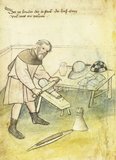
Bernhart Polyrer (c. 1425):
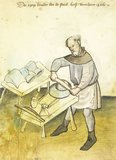
Hanns Derrer (1469):

Hanns Pernecker (1483):

Herman (1523):

Hanns Muller (1563):

Hans Schartt (1572):

-------------------------------
Some other polishers and grinders:
Harnischpolierer, Guillaume Vreland um 1460

Jan or Johannes Stradanus (originally: Jan van der Straet or Straeten) (1523-1605)
Polituva Armorum ('Polishing Armor')
"Swords, battle-axes and all the weapons of war,
are polished in our time, not in antiquity."**
Waterwheels below the workshop power the polishing apparatus.

1670 - Jan Brueghel the Younger - Venus at the Forge of Vulcan, detail
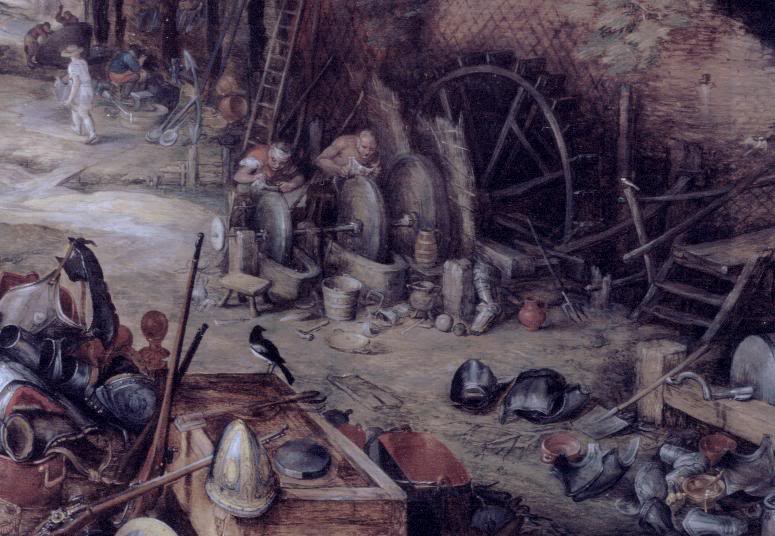
-------------------------------
Most of the depictions show "polishing", not grinding, if I understand the photos correctly. The only depiction of grinding at whetstone seems to be Brueghel's picture from 1670 - Venus at the Forge of Vulcan, large whetstones are half immersed in water basin. Some of the images show hand polishing with (presumably) wooden handle, covered with leather, while other show polishing at the mill driven wheel, covered with leather or felt.
I have read accounts from people doing experimental archaeology about polishing armour with leather covered handle and various abrasive mediums, from fine sand to pumice, wood ash and especially "jeweller's rouge" (Eisenrot, powdered iron oxide, usually hematite). They said that this really is polishing, it isn't useful for rough grinding which is much easier done with files and whetstones.
Armour polishers had their own guilds in some towns, and were not always connected to the armourers. In the above image of the Hanns Muller (1563) you can see that assembled armour pieces are held together by iron rod or wire!
Extant 15th Century German Gothic Armour
Extant 15th century Milanese armour
Arming doublet of the 15th century
|
|
   |
 |
Thomas R.

|
 Posted: Wed 06 Oct, 2010 11:27 am Post subject: Posted: Wed 06 Oct, 2010 11:27 am Post subject: |
 |
|
Seeing these depictions it comes clear, that the polisher was a highly specific craftsman. No ordinary soldier would have had the skill nor the tools to do it all by himself. So they had to pay for polishing, if wanted. It's not like polishing your porsche nowadays, it was more like applying a new laquer to the car. Perhaps servants could have maintained an already polished armor... So I assume, that mirror polished parts were more of an upper class thing, or for wealthier mercenaries.
My two cents,
Thomas
http://maerenundlobebaeren.tumblr.com/
|
|
   |
 |
J.D. Crawford

|
 Posted: Wed 06 Oct, 2010 1:13 pm Post subject: Posted: Wed 06 Oct, 2010 1:13 pm Post subject: |
 |
|
| Thomas R. wrote: | Seeing these depictions it comes clear, that the polisher was a highly specific craftsman. No ordinary soldier would have had the skill nor the tools to do it all by himself. So they had to pay for polishing, if wanted. It's not like polishing your porsche nowadays, it was more like applying a new laquer to the car. Perhaps servants could have maintained an already polished armor... So I assume, that mirror polished parts were more of an upper class thing, or for wealthier mercenaries.
My two cents,
Thomas |
You may well be right.
My point is that armor was not just armor, just like cars are not just cars - they were/are status symbols that make a statement about the owner. My guess is that as you went up the food chain to the highest nobility, they would be sure to go out in public with armor that shined, especially in ceremonial occasions. Shiny armor would mean that you can afford to buy good armor and afford to take care of it. Besides the pictures, there are various proud references to shiny armor and weapons in medieval writings. Makes me wonder why the current fashion amongst collectors is toward a satin finish rather than a mirror finish.
|
|
   |
 |
Blaz Berlec

|
 Posted: Wed 06 Oct, 2010 1:15 pm Post subject: Posted: Wed 06 Oct, 2010 1:15 pm Post subject: |
 |
|
Yes, polisher was a profession, polishers had their own guilds complete etc. But you have to look at what they were actually doing. As far as I know they received armours in pretty rough shape. I don't know who exactly did the preliminary grinding, but this roughly finished visor implies that it could be done at a later stage, at the polishers:
(image shared by Jiri Klepac)
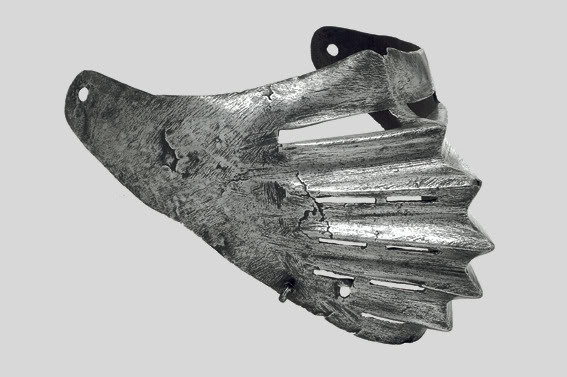
So they had quite a bit to do: grinding at various levels of coarseness, polishing at the end to various levels of finish, maybe even final assembly and adding straps in some cases. And they were polishing armour from pretty rough state.
End user would receive armour (if new) in pristine condition, and all he had to do was maintain the finish, not grind and polish the armour. Even on campaign I think soldiers (and I mean poorer soldiers, the ones without squires and pages) would have enough spare time to wipe the armour with the greasy rag or something similar, and even in heavy rain well oiled or greased or waxed armour is quite protected for quite a while. His armour and weapons were his tools of the trade, and being soldier was his profession - it is us with day jobs now that have trouble maintaining armour rust free, since we try to spend as little time as possible on it.
I can remember how my army boots shined after 10 - 15 minutes of polishing every evening in the army. There's no way I would do this now in my spare time.
I can imagine armour could be brought to polishers after a while for repolish and strap change. For instance before an important event where the wearer wanted to present himself in best light possible. But I don't think this would be necessary too often if armour was properly maintained.
Extant 15th Century German Gothic Armour
Extant 15th century Milanese armour
Arming doublet of the 15th century
|
|
   |
 |
|
Craig Shackleton
|
 Posted: Wed 06 Oct, 2010 1:27 pm Post subject: Posted: Wed 06 Oct, 2010 1:27 pm Post subject: |
 |
|
Speaking only based on personal experience, once a piece has been polished, it is less work to maintain the polish. Some people do, and some people don't. Quite often folks who can't afford a lot of gear are the ones who take the most care to keep it shiny. Some people are just borderline obsessive-compulsive about it. Some enjoy the process of maintaining their gear. Some just like the excuse to touch their beloved armour or sword or what have you. But then some people throw their gear in a bag and forget about it until they need it and they realize that it's rusted, and they do a quick clean up to make it serviceable, or if they can afford it, they take it to an expert with the right tools. some just let it rust, or paint it or something
I'd be willing to bet that the same was true of both common soldiers and wealthy knights, at least to some degree. Some took care of their kit, some had others to do it for them, and some just didn't take very good care of it.
Ottawa Swordplay
|
|
   |
 |
|
Aleksei Sosnovski
|
 Posted: Wed 06 Oct, 2010 2:40 pm Post subject: Posted: Wed 06 Oct, 2010 2:40 pm Post subject: |
 |
|
I am more concerned about the tools than about the time. Nowerdays you need a piece of scotch brite (or how this abrazive felt-like stuff is called?) to clean off quite severe rust, but it leaves satin finish. You need at least several grades of sand paper to achieve more or less mirror finish. Would a medieval soldier have access to analogue of such sand paper?
Another thing. When you fall to the sandy/stoney ground several times your armor inevitably gets scratched (knee protection usually suffers the most). And once the armor is scratched, it requires quite a lot of work (and some removed metal) to remove the scratches. Would an ordinary footmat do it? I doubt.
|
|
   |
 |
Blaz Berlec

|
|
   |
 |
|
Christopher Treichel
Location: Metro D.C. Joined: 14 Jan 2010
Posts: 268
|
 Posted: Thu 14 Jun, 2012 10:28 am Post subject: Posted: Thu 14 Jun, 2012 10:28 am Post subject: |
 |
|
|
As far as that experiement mentioned as to how long mirror polish will last in the elements. I am a reenactor who gets to tote a 44 inch long polished boom stick about. Polishing is done with a rag, sweet or boiled linseed oil and some brick dust. Takes only a few minutes to rub the whole barrel down and it will remain bright for a day or two depending on humidity. Indoors it will remain bright for months on end. On the other hand I have gone to sleep in a tent during a rain storm on a warm day with a bright and shiny boom sitck and woken up the next day with red finger prints all over it ready for more polishing... linseed oil seems to work a little better than sweet oil but not much. Best to keep that oily rag on hand in your pouch and any chance you get wipe down any metal parts.
|
|
  |
 |
Mackenzie Cosens

Location: Vancouver Canada Joined: 08 Aug 2007
Posts: 238
|
 Posted: Thu 14 Jun, 2012 11:27 am Post subject: Posted: Thu 14 Jun, 2012 11:27 am Post subject: |
 |
|
I have a memory of a conversation where it was mentioned that a piece of late 14th early 15th C arm harness was conserved and during the disassembly it was noted that surfaces on parts of the harness not easily visible and likely original where highly polished. Of course this is just a memory of a rumour, but maybe it will spark someone with better information to write.
Mackenzie
|
|
  |
 |
Blaz Berlec

|
 Posted: Tue 28 Sep, 2021 9:04 am Post subject: Posted: Tue 28 Sep, 2021 9:04 am Post subject: |
 |
|
I saw an amazing reference to polished armour on Facebook pages of groups Kurfürstlich Sächsische Kriegsknechte 1475 and later (with better translation) on Geschichtsfenster, I give here their text, original post is here:
https://www.facebook.com/Geschichtsfenster/posts/4667466296610417
The Eisenach town clerk and chronicler Johannes Rothe (1360-1434) gives a very detailed account of the condition of good armor in his "Ritterspiegel". Here is the translation after Huber and Kalnig (Johannes Rothe: Der Ritterspiegel. Edited, translated and commented by Christoph Huber and Pamela Kalnig. Walter de Gruyter, Berlin 2009)
“Vegetius also wants to speak
from the armor of a good knight,
that he should have it polished nicely,
so that there is neither rust nor ash on it.
His enemy is terrified
when he's so beautiful and pure
and he looks into him like in a mirror,
then he does not disregard the knight.
Who believes a knight
be strong, bold and also arguable
and courageous and free in his heart,
when his armor is all dirty,
looks black and soot-colored,
as if he had been found in the feces,
in addition torn and old,
as if he got it out of poverty
created? "
Original text according to Johannes Rothe:
„Vegecius der wel ouch segin
Von des gudin ritters harnasche,
Her sulle ez laßin schöne fegin,
Daz darane si weder rost noch asche.
Sin fient darvon irschrickit,
Wan ez schone ist und reyne
Und ez also eynen spigil anblickit,
So achtit her den ritter nicht kleyne.
Wer gloubit, daz eyn ritter sy
Starg, kune und ouch stritbar
Und sines gemutis freidig und fry,
Wan sin harnasch ist unfrutig gar,
Swarcz und ruezfar gestalt,
Also es in dem quate si fundin
Und zcurißin und ouch alt
Und habe sich dez ermelich
undirwundin?“
"Ritterspiegel" (Mirror of Chivalry) is a very long poem (4108 lines), and longest German medieval work on knighthood.
 Attachment: 140.94 KB Attachment: 140.94 KB
[ Download ]
Extant 15th Century German Gothic Armour
Extant 15th century Milanese armour
Arming doublet of the 15th century
|
|
   |
 |
|
|
You cannot post new topics in this forum
You cannot reply to topics in this forum
You cannot edit your posts in this forum
You cannot delete your posts in this forum
You cannot vote in polls in this forum
You cannot attach files in this forum
You can download files in this forum
|
All contents © Copyright 2003-2025 myArmoury.com — All rights reserved
Discussion forums powered by phpBB © The phpBB Group
Switch to the Basic Low-bandwidth Version of the forum
|

